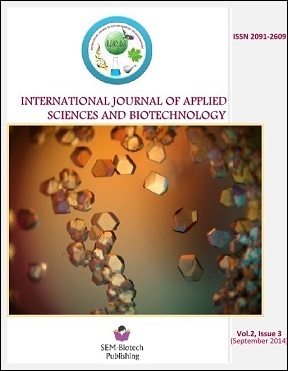Effect of Fermentation on Nutritional Composition of Selected Commonly Consumed Green Leafy Vegetables in Nigeria
DOI:
https://doi.org/10.3126/ijasbt.v2i3.11003Keywords:
Amanrathus hybridus, fermentation, nutritional composition, Pterocarpus mildbreadii, Telfaira occidentalis, Vernonia amygdalinaAbstract
Fresh leafy vegetables which include Amarathus hybridus (Bush green), Telfairia occidentalis (Fluted pumpkin leaf), Vernonia amygdalina (Bitter leaf) and Pterocarpus mildbraedii (White campwood leaf) were subjected to spontaneous fermentation for 5 days at room temperature. Physicochemical properties (pH, temperature, and total titratable acidity) were monitored during the fermentation. It was observed that the pH (6.8 to 3.78) of all the vegetables decreased steadily as fermentation progressed. However, the temperature (27°C to 34°C) and total titratable acidity expressed as lactic acid equivalent (0.014-0.147) for all the vegetables increased as fermentation progressed. The percentage of occurrence of bacteria isolated from the fermenting mass include Bacillus spp. (39.1%), Lactobacillus spp. (26.1%), Escherichia coli and Staphylococcus spp. (8.7%), Proteus spp., Serratia spp., Citrobacter spp. and Pseudomonas spp (4.3%) respectively. The proximate composition and mineral contents of fermented and unfermented leaves were investigated. Significant increase in ash content was noticed for unfermented (8.07%-15.72%) and for fermented vegetables (12.50%-23.28%). The protein contents of T. occidentalis (24.29%-25.65%), and A. hybridus (14.27%-16.96%) increased significantly after fermentation. A decrease in fiber content was noticed for all fermented vegetables except for V. amygdalina where significant increase was noticed (10.97%-14.55%). Increase in both thiamine (1.37-1.52mg/ml) and niacin (1.32-1.62mg/ml) contents were observed in T. occidentalis after fermentation while significant reductions were recorded for A. hybridus and V. amygdalina. Generally, vitamin C content of the vegetables decreased during fermentation while some increases were recorded in the mineral content of fermented vegetables.
DOI: http://dx.doi.org/10.3126/ijasbt.v2i3.11003
Int J Appl Sci Biotechnol, Vol. 2(3): 291-297




